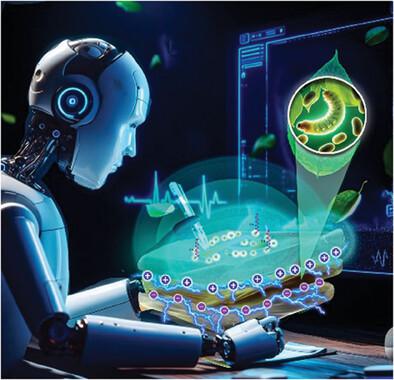当前位置:
X-MOL 学术
›
Adv. Mater. Technol.
›
论文详情
Our official English website, www.x-mol.net, welcomes your feedback! (Note: you will need to create a separate account there.)
A Mechanoluminescent ZnS:Cu/PDMS and Biocompatible Piezoelectric Silk Fibroin/PDMS Hybrid Sensor for Self‐Powered Sensing and Artificial Intelligence Control
Advanced Materials Technologies ( IF 6.8 ) Pub Date : 2024-04-15 , DOI: 10.1002/admt.202400255 Min‐Soo Kim 1 , Suman Timilsina 2 , Seong‐Min Jang 3 , Ji‐Sik Kim 1, 3 , Sang‐Shik Park 1, 3
Advanced Materials Technologies ( IF 6.8 ) Pub Date : 2024-04-15 , DOI: 10.1002/admt.202400255 Min‐Soo Kim 1 , Suman Timilsina 2 , Seong‐Min Jang 3 , Ji‐Sik Kim 1, 3 , Sang‐Shik Park 1, 3
Affiliation

|
Mechanoluminescence (ML) is luminescence induced due to mechanical stress, providing intuitive responses to strain‐related events. Piezoelectricity is the conversion of mechanical strain into electrical signals, offering a quantitative measurement of force/deformation. Combining ML and piezoelectricity within a single device provides a comprehensive understanding of mechanical events, providing qualitative and quantitative information about strain‐related phenomena. A ZnS:Cu/polydimethylsiloxane (PDMS) composite and a biocompatible silk fibroin/PDMS composite are prepared to generate ML and electrical signals, respectively. An innovative method for obtaining powder from silk fabrics is employed. The microstructure and composition of silk fibroin powder are also examined via X‐ray diffraction and Fourier Transform Infrared (FTIR) spectroscopy. Mechanical stimuli such as pressure, stretching, twisting, bending, vibration, and rubbing are applied to the device to demonstrate optical and electrical responses. Under pressure, a voltage of 3.82 V and an output current of 201.6 nA are generated at a force of 1 N. Furthermore, a handwritten test is conducted to qualitatively visualize letters based on ML effects and explore the feasibility of using artificial intelligence to classify voltage signals generated during writing into their corresponding letters. This biocompatible, dual‐modal self‐powered sensor demonstrates broad applicability in wearable technology, biomechanics, human–machine interaction, security, and energy harvesting.
中文翻译:

用于自供电传感和人工智能控制的机械发光 ZnS:Cu/PDMS 和生物相容性压电丝素蛋白/PDMS 混合传感器
机械发光(ML)是由于机械应力引起的发光,为应变相关事件提供直观的响应。压电是将机械应变转换为电信号,提供力/变形的定量测量。将机器学习和压电结合在单个设备中可以全面了解机械事件,提供有关应变相关现象的定性和定量信息。制备了 ZnS:Cu/聚二甲基硅氧烷 (PDMS) 复合材料和生物相容性丝素蛋白/PDMS 复合材料,分别产生 ML 和电信号。采用了一种从丝织物中获取粉末的创新方法。还通过 X 射线衍射和傅里叶变换红外 (FTIR) 光谱检查了丝素蛋白粉末的微观结构和成分。对设备施加压力、拉伸、扭转、弯曲、振动和摩擦等机械刺激,以演示光学和电响应。在压力下,1 N 的力产生 3.82 V 的电压和 201.6 nA 的输出电流。此外,还进行了手写测试,以定性可视化基于 ML 效应的字母,并探索使用人工智能对电压进行分类的可行性写入相应字母时产生的信号。这种生物相容性、双模式自供电传感器在可穿戴技术、生物力学、人机交互、安全和能量收集方面表现出广泛的适用性。
更新日期:2024-04-15
中文翻译:

用于自供电传感和人工智能控制的机械发光 ZnS:Cu/PDMS 和生物相容性压电丝素蛋白/PDMS 混合传感器
机械发光(ML)是由于机械应力引起的发光,为应变相关事件提供直观的响应。压电是将机械应变转换为电信号,提供力/变形的定量测量。将机器学习和压电结合在单个设备中可以全面了解机械事件,提供有关应变相关现象的定性和定量信息。制备了 ZnS:Cu/聚二甲基硅氧烷 (PDMS) 复合材料和生物相容性丝素蛋白/PDMS 复合材料,分别产生 ML 和电信号。采用了一种从丝织物中获取粉末的创新方法。还通过 X 射线衍射和傅里叶变换红外 (FTIR) 光谱检查了丝素蛋白粉末的微观结构和成分。对设备施加压力、拉伸、扭转、弯曲、振动和摩擦等机械刺激,以演示光学和电响应。在压力下,1 N 的力产生 3.82 V 的电压和 201.6 nA 的输出电流。此外,还进行了手写测试,以定性可视化基于 ML 效应的字母,并探索使用人工智能对电压进行分类的可行性写入相应字母时产生的信号。这种生物相容性、双模式自供电传感器在可穿戴技术、生物力学、人机交互、安全和能量收集方面表现出广泛的适用性。



























 京公网安备 11010802027423号
京公网安备 11010802027423号